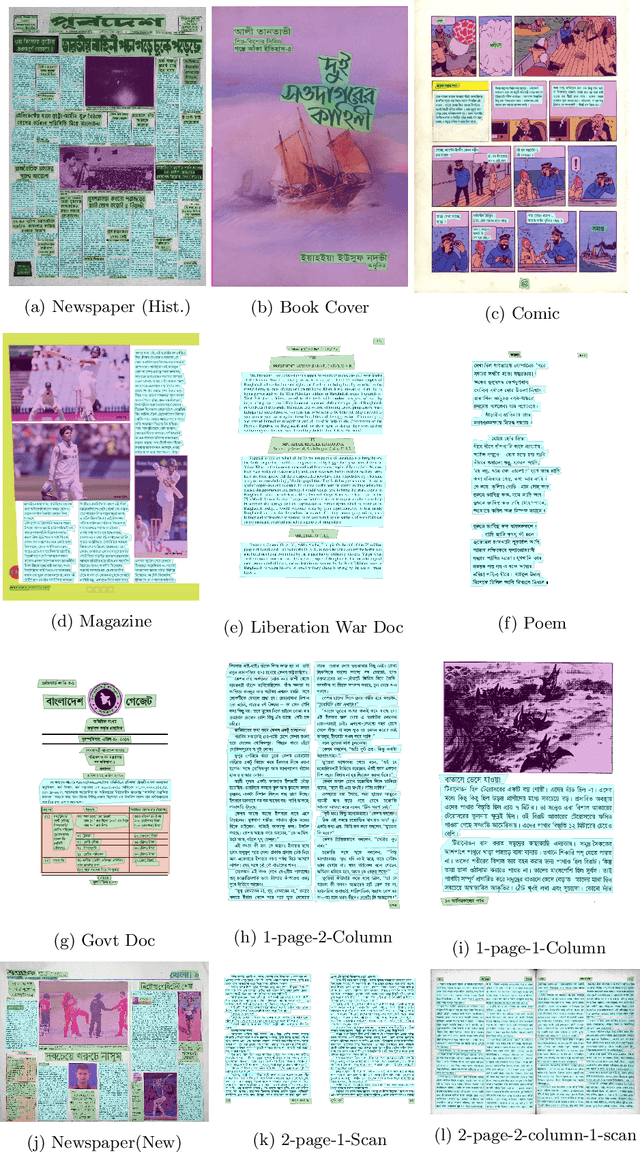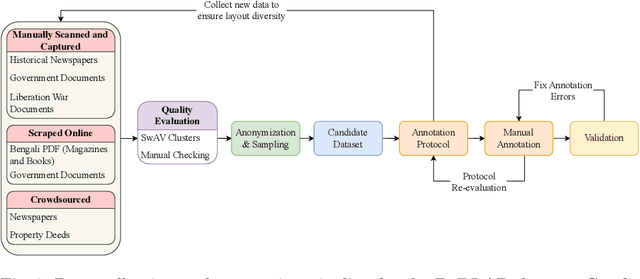Farig Sadeque
How Effectively Can BERT Models Interpret Context and Detect Bengali Communal Violent Text?
Jun 24, 2025Abstract:The spread of cyber hatred has led to communal violence, fueling aggression and conflicts between various religious, ethnic, and social groups, posing a significant threat to social harmony. Despite its critical importance, the classification of communal violent text remains an underexplored area in existing research. This study aims to enhance the accuracy of detecting text that incites communal violence, focusing specifically on Bengali textual data sourced from social media platforms. We introduce a fine-tuned BanglaBERT model tailored for this task, achieving a macro F1 score of 0.60. To address the issue of data imbalance, our dataset was expanded by adding 1,794 instances, which facilitated the development and evaluation of a fine-tuned ensemble model. This ensemble model demonstrated an improved performance, achieving a macro F1 score of 0.63, thus highlighting its effectiveness in this domain. In addition to quantitative performance metrics, qualitative analysis revealed instances where the models struggled with context understanding, leading to occasional misclassifications, even when predictions were made with high confidence. Through analyzing the cosine similarity between words, we identified certain limitations in the pre-trained BanglaBERT models, particularly in their ability to distinguish between closely related communal and non-communal terms. To further interpret the model's decisions, we applied LIME, which helped to uncover specific areas where the model struggled in understanding context, contributing to errors in classification. These findings highlight the promise of NLP and interpretability tools in reducing online communal violence. Our work contributes to the growing body of research in communal violence detection and offers a foundation for future studies aiming to refine these techniques for better accuracy and societal impact.
Med-IC: Fusing a Single Layer Involution with Convolutions for Enhanced Medical Image Classification and Segmentation
Sep 27, 2024Abstract:The majority of medical images, especially those that resemble cells, have similar characteristics. These images, which occur in a variety of shapes, often show abnormalities in the organ or cell region. The convolution operation possesses a restricted capability to extract visual patterns across several spatial regions of an image. The involution process, which is the inverse operation of convolution, complements this inherent lack of spatial information extraction present in convolutions. In this study, we investigate how applying a single layer of involution prior to a convolutional neural network (CNN) architecture can significantly improve classification and segmentation performance, with a comparatively negligible amount of weight parameters. The study additionally shows how excessive use of involution layers might result in inaccurate predictions in a particular type of medical image. According to our findings from experiments, the strategy of adding only a single involution layer before a CNN-based model outperforms most of the previous works.
Mapping Violence: Developing an Extensive Framework to Build a Bangla Sectarian Expression Dataset from Social Media Interactions
Apr 17, 2024Abstract:Communal violence in online forums has become extremely prevalent in South Asia, where many communities of different cultures coexist and share resources. These societies exhibit a phenomenon characterized by strong bonds within their own groups and animosity towards others, leading to conflicts that frequently escalate into violent confrontations. To address this issue, we have developed the first comprehensive framework for the automatic detection of communal violence markers in online Bangla content accompanying the largest collection (13K raw sentences) of social media interactions that fall under the definition of four major violence class and their 16 coarse expressions. Our workflow introduces a 7-step expert annotation process incorporating insights from social scientists, linguists, and psychologists. By presenting data statistics and benchmarking performance using this dataset, we have determined that, aside from the category of Non-communal violence, Religio-communal violence is particularly pervasive in Bangla text. Moreover, we have substantiated the effectiveness of fine-tuning language models in identifying violent comments by conducting preliminary benchmarking on the state-of-the-art Bangla deep learning model.
IPA Transcription of Bengali Texts
Mar 29, 2024Abstract:The International Phonetic Alphabet (IPA) serves to systematize phonemes in language, enabling precise textual representation of pronunciation. In Bengali phonology and phonetics, ongoing scholarly deliberations persist concerning the IPA standard and core Bengali phonemes. This work examines prior research, identifies current and potential issues, and suggests a framework for a Bengali IPA standard, facilitating linguistic analysis and NLP resource creation and downstream technology development. In this work, we present a comprehensive study of Bengali IPA transcription and introduce a novel IPA transcription framework incorporating a novel dataset with DL-based benchmarks.
Gazetteer-Enhanced Bangla Named Entity Recognition with BanglaBERT Semantic Embeddings K-Means-Infused CRF Model
Jan 30, 2024Abstract:Named Entity Recognition (NER) is a sub-task of Natural Language Processing (NLP) that distinguishes entities from unorganized text into predefined categorization. In recent years, a lot of Bangla NLP subtasks have received quite a lot of attention; but Named Entity Recognition in Bangla still lags behind. In this research, we explored the existing state of research in Bangla Named Entity Recognition. We tried to figure out the limitations that current techniques and datasets face, and we would like to address these limitations in our research. Additionally, We developed a Gazetteer that has the ability to significantly boost the performance of NER. We also proposed a new NER solution by taking advantage of state-of-the-art NLP tools that outperform conventional techniques.
Involution Fused ConvNet for Classifying Eye-Tracking Patterns of Children with Autism Spectrum Disorder
Jan 07, 2024Abstract:Autism Spectrum Disorder (ASD) is a complicated neurological condition which is challenging to diagnose. Numerous studies demonstrate that children diagnosed with autism struggle with maintaining attention spans and have less focused vision. The eye-tracking technology has drawn special attention in the context of ASD since anomalies in gaze have long been acknowledged as a defining feature of autism in general. Deep Learning (DL) approaches coupled with eye-tracking sensors are exploiting additional capabilities to advance the diagnostic and its applications. By learning intricate nonlinear input-output relations, DL can accurately recognize the various gaze and eye-tracking patterns and adjust to the data. Convolutions alone are insufficient to capture the important spatial information in gaze patterns or eye tracking. The dynamic kernel-based process known as involutions can improve the efficiency of classifying gaze patterns or eye tracking data. In this paper, we utilise two different image-processing operations to see how these processes learn eye-tracking patterns. Since these patterns are primarily based on spatial information, we use involution with convolution making it a hybrid, which adds location-specific capability to a deep learning model. Our proposed model is implemented in a simple yet effective approach, which makes it easier for applying in real life. We investigate the reasons why our approach works well for classifying eye-tracking patterns. For comparative analysis, we experiment with two separate datasets as well as a combined version of both. The results show that IC with three involution layers outperforms the previous approaches.
BanglaBait: Semi-Supervised Adversarial Approach for Clickbait Detection on Bangla Clickbait Dataset
Nov 10, 2023Abstract:Intentionally luring readers to click on a particular content by exploiting their curiosity defines a title as clickbait. Although several studies focused on detecting clickbait titles in English articles, low resource language like Bangla has not been given adequate attention. To tackle clickbait titles in Bangla, we have constructed the first Bangla clickbait detection dataset containing 15,056 labeled news articles and 65,406 unlabelled news articles extracted from clickbait dense news sites. Each article has been labeled by three expert linguists and includes an article's title, body, and other metadata. By incorporating labeled and unlabelled data, we finetune a pretrained Bangla transformer model in an adversarial fashion using Semi Supervised Generative Adversarial Networks (SS GANs). The proposed model acts as a good baseline for this dataset, outperforming traditional neural network models (LSTM, GRU, CNN) and linguistic feature based models. We expect that this dataset and the detailed analysis and comparison of these clickbait detection models will provide a fundamental basis for future research into detecting clickbait titles in Bengali articles. We have released the corresponding code and dataset.
bbOCR: An Open-source Multi-domain OCR Pipeline for Bengali Documents
Aug 22, 2023Abstract:Despite the existence of numerous Optical Character Recognition (OCR) tools, the lack of comprehensive open-source systems hampers the progress of document digitization in various low-resource languages, including Bengali. Low-resource languages, especially those with an alphasyllabary writing system, suffer from the lack of large-scale datasets for various document OCR components such as word-level OCR, document layout extraction, and distortion correction; which are available as individual modules in high-resource languages. In this paper, we introduce Bengali$.$AI-BRACU-OCR (bbOCR): an open-source scalable document OCR system that can reconstruct Bengali documents into a structured searchable digitized format that leverages a novel Bengali text recognition model and two novel synthetic datasets. We present extensive component-level and system-level evaluation: both use a novel diversified evaluation dataset and comprehensive evaluation metrics. Our extensive evaluation suggests that our proposed solution is preferable over the current state-of-the-art Bengali OCR systems. The source codes and datasets are available here: https://bengaliai.github.io/bbocr.
OOD-Speech: A Large Bengali Speech Recognition Dataset for Out-of-Distribution Benchmarking
May 15, 2023Abstract:We present OOD-Speech, the first out-of-distribution (OOD) benchmarking dataset for Bengali automatic speech recognition (ASR). Being one of the most spoken languages globally, Bengali portrays large diversity in dialects and prosodic features, which demands ASR frameworks to be robust towards distribution shifts. For example, islamic religious sermons in Bengali are delivered with a tonality that is significantly different from regular speech. Our training dataset is collected via massively online crowdsourcing campaigns which resulted in 1177.94 hours collected and curated from $22,645$ native Bengali speakers from South Asia. Our test dataset comprises 23.03 hours of speech collected and manually annotated from 17 different sources, e.g., Bengali TV drama, Audiobook, Talk show, Online class, and Islamic sermons to name a few. OOD-Speech is jointly the largest publicly available speech dataset, as well as the first out-of-distribution ASR benchmarking dataset for Bengali.
BaDLAD: A Large Multi-Domain Bengali Document Layout Analysis Dataset
Mar 10, 2023



Abstract:While strides have been made in deep learning based Bengali Optical Character Recognition (OCR) in the past decade, the absence of large Document Layout Analysis (DLA) datasets has hindered the application of OCR in document transcription, e.g., transcribing historical documents and newspapers. Moreover, rule-based DLA systems that are currently being employed in practice are not robust to domain variations and out-of-distribution layouts. To this end, we present the first multidomain large Bengali Document Layout Analysis Dataset: BaDLAD. This dataset contains 33,695 human annotated document samples from six domains - i) books and magazines, ii) public domain govt. documents, iii) liberation war documents, iv) newspapers, v) historical newspapers, and vi) property deeds, with 710K polygon annotations for four unit types: text-box, paragraph, image, and table. Through preliminary experiments benchmarking the performance of existing state-of-the-art deep learning architectures for English DLA, we demonstrate the efficacy of our dataset in training deep learning based Bengali document digitization models.
 Add to Chrome
Add to Chrome Add to Firefox
Add to Firefox Add to Edge
Add to Edge